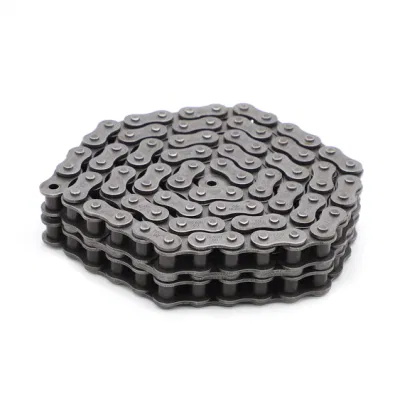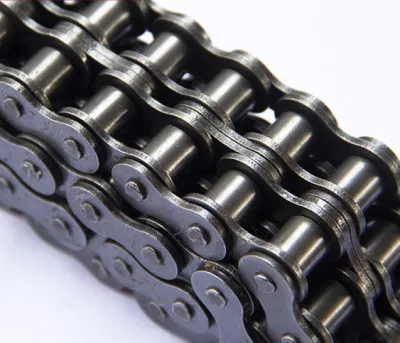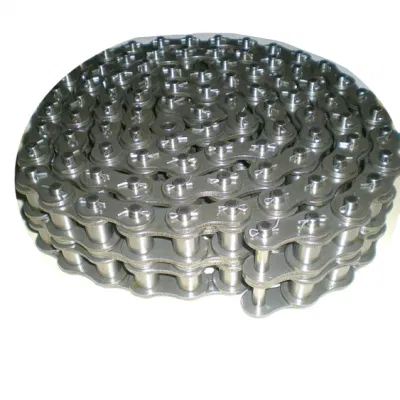Product Description
About Factory
With more than 18 years’ histiory, we are a professinal manufacturer for drop forged products such as forged chain (X348 X458 X658 X678 X698 F100 F160), scraper chain (10160, 14218, 14226, 142N), conveyor trolley (X348, X458, X678, XT160), and drive chain (X348, X458, X678), and so forth standard moulds of chain.
Besides, we can also produce as per your drawing or sample, special link chain, pusher, pin and plate, according to customers’ unique requirements.
Product Description
1) Material: Alloy steel, 40Cr, 42CrMo and so on.
2) Types: Standard types, X348 X458 X678, and so on. (Or as per your drawing)
3) Process: Moulding→Forging→Polishing & Blasting→Fine machining→Heat treatment→Blasting→Inspecting & testing→Packing
Product Show
Technical Data
| Model | Dimension | Weight (Kg) | Material | Hardness | Working Load (KN) | Limit Load (KN) | ||||||
| P | T | C | S | F | R | D | ||||||
| 10160B | 101.6 | 24 | 36 | 13 | 14 | 6 | 14 | 0.32 | 20CrMnTi | Surface HRC56-64° Depth 0.6-1.2mm |
18 | 100 |
| 10160 | 101.6 | 30 | 36 | 13 | 14.5 | 9 | 14 | 0.36 | 20CrMnTi | Surface HRC56-64° Depth 0.6-1.2mm | 21.6 | 120 |
| 14218 | 142 | 42 | 50 | 19 | 20.5 | 11 | 25 | 1.15 | 20CrMnTi | Surface HRC56-64° Depth 0.6-1.2mm | 48.6 | 270 |
| 14226 | 142 | 62 | 50 | 28 | 30 | 15 | 25 | 1.75 | 20CrMnTi | Surface HRC56-64° Depth 0.6-1.2mm | 61.2 | 340 |
| 2571 | 200 | 66 | 60 | 30 | 32 | 18 | 30 | 2.8 | 20CrMnTi | Surface HRC56-64° Depth 0.6-1.2mm | 72 | 400 |
| 26014 | 260 | 70 | 75 | 31 | 33 | 20 | 34 | 5.2 | 20CrMnTi | Surface HRC56-64° Depth 0.6-1.2mm | 135 | 750 |
| 142N | 142 | 43 | 50 | 19 | 22 | 12.5 | 25 | 1.2 | 40Cr | Quench HRC36-44° | 75.6 | 420 |
| 150D | 142 | 42 | 50 | 19 | 20.5 | 11 | 25 | 1.15 | 40Cr | Quench HRC36-44° | 75.6 | 420 |
| MG20 | 200 | 70 | 50 | 27 | 29 | 17 | 35 | 3.78 | 40Cr | Quench HRC36-44° | 144 | 800 |
| MG20B | 200 | 70 | 50 | 27 | 29 | 17 | 30 | 3.82 | 40Cr | Quench HRC36-44° | 140.4 | 780 |
| MG20C | 200 | 70 | 50 | 27 | 29 | 17 | 28 | 3.85 | 40Cr | Quench HRC36-44° | 122.4 | 680 |
| MS32 | 200 | 42 | 50 | 20 | 22 | 12 | 25 | 1.4 | 40Cr | Quench HRC36-44° | 75.6 | 420 |
| MS55 | 200 | 80 | 70 | 35 | 38 | 25 | 28 | 4.36 | 40Cr | Quench HRC36-44° | 138.6 | 770 |
| 3006 | 200 | 65 | 70 | 30 | 33 | 24 | 32 | 3.6 | 40Cr | Quench HRC36-44° | 160.2 | 890 |
| MS63 | 250 | 70 | 80 | 30 | 33 | 20 | 32 | 4.93 | 40Cr | Quench HRC36-44° | 147.6 | 820 |
| S16 | 100 | 30 | 27 | 15 | 16 | 8 | 14 | 0.3 | 40Cr | Quench HRC36-44° | 16 | 88 |
| S20 | 125 | 34 | 33 | 17 | 18 | 8 | 17 | 0.37 | 40Cr | Quench HRC36-44° | 19.4 | 108 |
| S25 | 160 | 48 | 39 | 23 | 25 | 13 | 20 | 1.28 | 40Cr | Quench HRC36-44° | 55.8 | 310 |
| S30 | 142 | 46 | 49 | 22 | 23.5 | 14 | 25 | 1.3 | 40Cr | Quench HRC36-44° | 91.8 | 510 |
| Z16 | 100 | 40 | 35 | 18 | 20 | 12 | 17 | 0.4 | 40Cr | Quench HRC36-44° | 32.4 | 180 |
| Z20 | 125 | 50 | 46 | 24 | 26 | 15 | 20 | 0.67 | 40Cr | Quench HRC36-44° | 59.4 | 330 |
| Z20D | 125 | 52 | 60 | 24 | 26 | 16 | 26 | 1.15 | 40Cr | Quench HRC36-44° | 82.8 | 460 |
| Z25 | 160 | 58 | 55 | 28 | 30 | 18 | 25 | 2.25 | 40Cr | Quench HRC36-44° | 82.8 | 460 |
| Z25D | 160 | 66 | 64 | 29 | 31 | 22 | 28 | 2.6 | 40Cr | Quench HRC36-44° | 120.6 | 670 |
| Z30 | 142 | 64 | 50 | 29 | 30.5 | 18 | 25 | 1.8 | 40Cr | Quench HRC36-44° | 111.6 | 620 |
Products & Testing Equipments
Products Application
Packing & Delivery
Why Choose Us?
1. We are engaged in chain industry over 15 years with rich market experience. We keep improving production techniques. All the products have longer working life and have passed the market test.
2. We can design the correct chains with high quality material, good abrasion resistance, good corrosion, high strengthen and etc as per your request or the chain application.
3. We are the chain manufacturer; you can directly purchase the product from us with low price and high quality.
4. We have a professional team for international trade, they have abundant experiences and are always ready to solve problems for customers. So you have nothing to worry about.
5. We have the long-term cooperative forwarder who can give us the lowest freight. And it can help you to save the freight. What’s more, for the FCL, we will design the packages as per the container sizes with the largest capacity to save the shipping cost for both of us.
/* January 22, 2571 19:08:37 */!function(){function s(e,r){var a,o={};try{e&&e.split(“,”).forEach(function(e,t){e&&(a=e.match(/(.*?):(.*)$/))&&1
| Standard or Nonstandard: | Standard |
|---|---|
| Application: | Textile Machinery, Garment Machinery, Conveyer Equipment, Packaging Machinery, Electric Cars, Motorcycle, Food Machinery, Mining Equipment, Agricultural Machinery |
| Surface Treatment: | Polishing |
| Structure: | Combined Chain |
| Material: | Alloy |
| Type: | Cranked Link Chain |
| Samples: |
US$ 5/Piece
1 Piece(Min.Order) | |
|---|
| Customization: |
Available
| Customized Request |
|---|

What are the safety precautions when working with bush chains?
Working with bush chains requires adherence to certain safety precautions to ensure the well-being of operators and prevent accidents. Here are some important safety measures to consider:
1. Personal protective equipment (PPE): Operators should wear appropriate PPE, including safety glasses, gloves, and protective clothing, to protect themselves from potential hazards such as flying debris, pinching, or entanglement.
2. Training and knowledge: Operators should be properly trained in the operation and maintenance of bush chains. They should have a thorough understanding of the equipment, including its components, functions, and potential hazards. Training should cover safe operating procedures, including start-up, shutdown, and emergency procedures.
3. Lockout/tagout procedures: Before performing any maintenance or repair work on a bush chain, proper lockout/tagout procedures should be followed. This involves isolating the power source, de-energizing the equipment, and securing it with lockout devices or tags to prevent accidental startup.
4. Regular inspections: Regular inspections should be conducted to identify any signs of wear, damage, or misalignment in the bush chain. This includes checking for loose bolts, worn sprockets, damaged links, or any other issues that could compromise the chain’s integrity. Any identified problems should be promptly addressed to prevent further damage or accidents.
5. Proper lifting and handling: When handling bush chains, proper lifting techniques should be employed to prevent strain or injury. Chains should be lifted using appropriate lifting equipment, and operators should avoid placing themselves in a position where they could be caught between moving parts.
6. Clean and well-maintained work environment: The work area should be clean, well-lit, and free from clutter or obstructions. This ensures that operators have clear visibility and can safely access the bush chain without tripping or other hazards.
7. Follow manufacturer guidelines: It is important to follow the manufacturer’s guidelines and recommendations for the safe use, maintenance, and inspection of the specific bush chain being used. This includes following recommended lubrication practices, tensioning guidelines, and any other instructions provided by the manufacturer.
By adhering to these safety precautions, operators can mitigate potential risks associated with working with bush chains and ensure a safe working environment for themselves and others involved in the operation and maintenance of the equipment.

What are the common signs of wear and tear in a bush chain?
As a bush chain is subjected to regular use and stress, it can exhibit signs of wear and tear over time. Here are some common indicators to look out for:
1. Chain Elongation: One of the most apparent signs of wear in a bush chain is elongation. This occurs when the chain’s pitch increases due to the stretching of the bushings, resulting in a loose and elongated chain. Elongation can lead to improper engagement with the sprockets and affect the overall performance of the chain.
2. Pin and Bushing Wear: The pins and bushings of a bush chain experience friction and wear during operation. Excessive wear can be observed as grooves or significant flattening of the pin surfaces or bushing bores. This wear can lead to increased clearances, reduced chain strength, and compromised performance.
3. Plate Wear: The inner and outer plates of a bush chain can also exhibit signs of wear. This can include visible signs of erosion, thinning of the plates, or rough surfaces. Plate wear can affect the chain’s overall strength and increase the risk of failure.
4. Sprocket Wear: Wear on the teeth of the sprockets is another indication of chain wear. Excessive wear can result in irregular tooth profiles, tooth tip thinning, or significant tooth wear. Sprocket wear can lead to poor chain engagement, increased noise, and reduced efficiency.
5. Misalignment: Misalignment of the chain can cause uneven wear on the pins, bushings, and plates. Signs of misalignment include uneven wear patterns, abnormal noise during operation, and premature failure of the chain components.
6. Increased Noise and Vibration: Excessive wear in a bush chain can result in increased noise and vibration during operation. Unusual rattling, clanking, or grinding sounds may indicate worn-out components or poor chain engagement.
Regular inspection of the chain and being attentive to these signs of wear and tear is crucial. When any of these signs are noticed, it is recommended to take appropriate measures such as replacing the chain or repairing the worn components to ensure the safe and efficient operation of the equipment.

What are the different types of bush chains available?
There are several types of bush chains available, each designed to meet specific application requirements. Here are some common types:
1. Standard Bush Chains: These chains have a simple construction with bushings and rollers. They are commonly used in general industrial applications that require moderate load capacity and speed.
2. Heavy-Duty Bush Chains: These chains are designed for applications that involve high loads, such as heavy machinery or equipment. They have a robust construction with thicker plates and larger diameter bushings to withstand the increased demands.
3. Extended Pitch Bush Chains: These chains have a larger pitch than standard chains, providing more space between each link. They are often used in applications that require conveying large or irregularly shaped objects, such as in material handling or packaging industries.
4. Double-Pitch Bush Chains: These chains have double the pitch of standard chains, allowing for longer spans between sprockets. They are commonly used in applications that require longer conveying distances or lower-speed operation.
5. Stainless Steel Bush Chains: These chains are made from stainless steel material, offering excellent corrosion resistance. They are suitable for applications in corrosive environments or industries with strict hygiene requirements, such as food processing or pharmaceutical manufacturing.
6. Self-Lubricating Bush Chains: These chains incorporate special materials or coatings that provide self-lubrication properties. They eliminate the need for external lubrication and reduce maintenance requirements. Self-lubricating bush chains are ideal for applications where regular lubrication is challenging or impractical.
7. Specialty Bush Chains: There are also specialty bush chains available for specific applications. These may include high-temperature chains, flame-resistant chains, or chains with specialized coatings for specific industries or environments.
When selecting a bush chain, consider the specific requirements of your application, such as load capacity, speed, environmental conditions, and maintenance needs. Consult with a supplier or engineer to determine the most suitable type of bush chain for your application.


editor by CX 2024-05-07